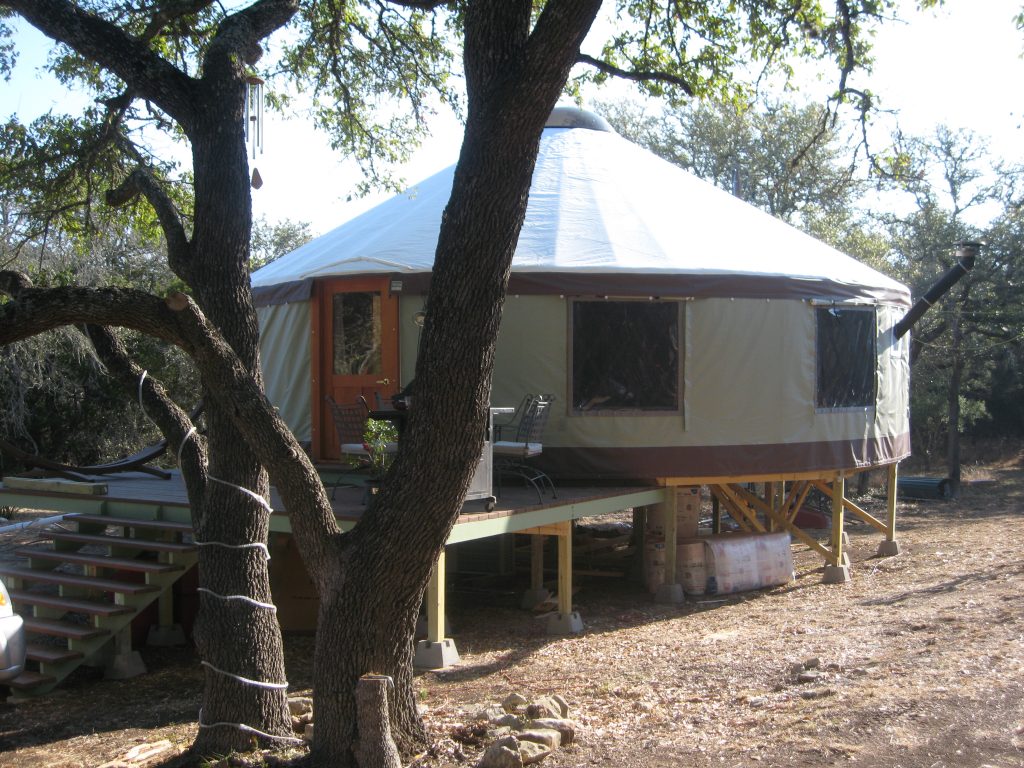By Annabelle Podmore
Over the river and through the woods.
Social studies teacher Heather Draker lives on 15 acres of land in Canyon Lake.
Her mother-in-law also lives on their property, beyond a creek.
In a house made out of a shipping container.
“When we got pregnant, we knew that we wanted our parents to be very involved in our daughter’s life,” Draker said. “We had already built our house next to my parents’ house, so we thought we could build my husband’s mom a small house on our land, on the other side of the creek. After looking at several different options, she decided on a shipping container.”
They bought the shipping container from downtown San Antonio for $2,500. Once it was delivered, Draker’s husband and his brother set to work turning it into a house. The total cost was around $13,000.
“We looked at tiny homes, at micro-homes, and then at shipping container homes. She liked those best because if you wanted to move it, you could literally rent space on the back of an 18-wheeler and have it moved wherever you wanted,” Draker said. “She also liked that we were reusing something that’s already kind of wasted, and creating something else out of it.”
Since Draker’s mother-in-law lives alone, she wanted something sustainable and easy to maintain. Like Draker’s own house, it uses minimal electricity and a greywater system, which reuses water from the bathroom sink, shower, and laundry for watering plants.
“I think every neighborhood should have a greywater system, because it’s an easy way to use less water, especially in Texas when we’re constantly living in drought,” Draker said. “We only use castile soap in the shower and sink since we water our food crops with that water, so it’s safe. We made a bunch of things in our house eco-friendly and she knew that, so she wanted that for her house too.”
Draker knows a thing or two about unique living situations. Before building her current house, she and her husband used to live in a yurt. A yurt is a round Mongolian house, easily portable to accommodate traditional Mongolian hunting patterns.
“We had just sold our house in San Antonio and we were deciding where to live. We didn’t know if we wanted to stay in Texas, and we really loved Oregon so we were considering moving there, but we didn’t want to do anything hasty,” Draker said. “I have a large plot of land that’s my inheritance from my parents, so we decided to get a yurt and live in it there while we decided what we wanted to do.”
For $17,000, Draker and her husband bought a yurt from Colorado and had it delivered in two crates. The yurt had a 30-foot diameter -roughly the size of a classroom.
“We wanted to build it off the ground because there’s a lot of scorpions and snakes where we live, so we built a platform for it and we put in a wood floor, and then we put the yurt up,” Draker said. “It was me and my husband, our two best friends, and a couple other people who came out to help us with the hard part, which was the roof. We put up the structure, step by step, and then we pulled on the roof liner, the roof, and we had a house.”
The yurt had three layers to it; an outer layer, an insulation layer, and the inner layer. The outer layer was made of thick canvas, so it looked like a tent.
“The platform took about three weekends, or six days, to build. Putting the actual structure on top of it took less than a day, maybe six hours. It helped that there were around six of us doing it,” Draker said. “We did that over Thanksgiving weekend in 2009, and we lived there for four years.”
The yurt required a lot of air conditioning to keep the canvas-lined interior cool during summer. It was ultimately too expensive and not very eco-friendly, so Draker and her husband sold it and began house-hunting again. They took a two-month road trip one summer to see their options.
“We finally decided to stay in Texas because it was more affordable, and I love working here. The thought of leaving my job was so disheartening to me. I didn’t want to start over in another city when I knew that I already liked where I was,” Draker said. “As a teacher, it also enabled us to save money, because living here is so cheap, and that lets us travel during the summers, which is what I’m really passionate about.”
Having gained experience from living in a yurt, Draker was able to advise her mother-in-law when it came time for her own small home.
“When we wanted her to be next to us, we told her a yurt wasn’t the best option because we knew how much electricity we used in air conditioning it,” Draker said. “As much as we loved the yurt, we also knew that it wouldn’t work for her, because she didn’t want to be wasting energy.”
Even now, Draker and her husband have stuck to the minimalist lifestyle they adopted while living in the yurt.
“When we sold our house and decided to put the yurt up, we essentially decided we would have to get rid of a bunch of stuff. Living in a one-room house really changed our mindset, and made us think about what we need, and what resources we’re using,” Draker said. “Our house, while bigger than a yurt now, is sparse, because we don’t buy stuff just to buy stuff. It really brought us closer to the earth, and made us want to stay that way.”

